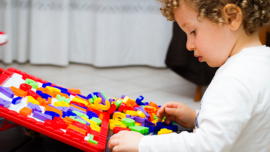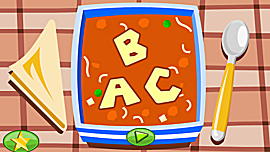Writing tips & tricks

Try these 10 tips to help children hone their writing skills.
Reading and writing go hand in hand, so just as you are helping and encouraging your child to read it is equally important to practice writing techniques.
Here are some tips and tricks my students use while they
- Brainstorm topics they want to write a story about. I have my students use a story map template (like the one pictured) to draw a quick picture of the ideas they are thinking about writing about. Each different story idea goes in one of the shape bubbles. Kindergartners always have something they want to say or share. Have them take those words and ideas and practice writing them down on paper.
- Choose one idea to focus on and write about. Have your child choose the story they are most excited about telling. If they used the story map sheet, have your child outline the bubble around the picture that shows the story they have chosen to write about. This helps your child focus on what they will write about and saves other ideas for the next time they sit down to practice writing.
- Make writing materials easily accessible. Plain or lined paper, pencils colored pencils,crayons, and markers. In my classroom I prefer having the
children write in the primary journal shown. What I like about this journal is it has a blank space at the top for an illustration and has nice wide lines for the children to write on below. With the blank paper at the top and the lines on the bottom I have found that it makes the task of writing seem less daunting or intimidating. In the past, I have provided blank paper to the kids and most seemed anxious as to how they were supposed to fill the blank page. This primary journal helps give your child some guidance and direction. - Draw the story first. Drawing allows your child to express their story. Chances are they have been drawing (even it was just scribbles) as soon as they were able to hold a crayon. Drawing gets the ideas down on the paper and gets the brain stimulated and focused on the story they want to share.
- Break it down. Kids have so much to say sometimes they have trouble writing it all down or they don't know where it start -they have this great illustration and now they have to focus on putting down words. In order to break the story down, think one sentence at a time. Ask your child, "What do you want to tell me first?" Listen to their first sentence, then have them repeat that sentence again.
- Count the words in their sentence on their fingers. Once they have repeated the sentence they want write, have your child count those words by using their fingers. For example, if their sentence is, I went to the park, then your child will stick out one finger each time they say one word. For I - your child sticks out their thumb, went -pointer finger, to -middle finger, the -ring finger, park -pinky finger. Ask, "How many words in your sentence?" Child looks at their fingers sticking up and replies, "5!".
- Write the words one by one. Now your child is ready to write their sentence and by using their fingers to remember the words makes it less likely they will leave out a word. "Okay, write the first word in your sentence." -I. "Okay, now write the next word." -went. "Great write down the sounds you hear in went -say the word slowly so you can hear all the sounds." *It is very typical at this age that your child will write, wet ,for went, and that okay -they are hearing a beginning, middle, and ending sound and that is wonderful, so be supportive and excited even if it is misspelled.
Continue this way until the sentence is complete. - Go back and re-read. Make sure after your child has written their sentence that they go back and check their work. First have them count how many words in their sentence. Do the number of words match the number of fingers you had up? -It should. No matter if the number matches or not, have your child go back and re-read what they wrote on the paper. Does the sentence make sense? If not where is the problem? Maybe they noticed they forgot a word or forgot a sound in a word, or maybe they are able to read it perfectly and it is just how they want it. Continue writing sentence by sentence until they are finished with the whole story.
- Share the story. Have your child share their story by reading the words they put down on the paper. If they read to both mom and dad, but don't have siblings to share with have your child read to some of their favorite stuffed animals.
- Pick one thing to help them with the next time you write with them. When you watch your child write you may notice some errors they are making. Instead of pointing out all their errors and making them erase their mistakes use those mistakes as teachable moments to come. You may notice your child is stringing their words together, next time focus on using spaces between their words to it makes it easier to read and understand. You may notice other things to focus on, such as, writing left to right and top to bottom, using a capital at the beginning of their sentence and a punctuation mark at the end, etc. These are all things that can come later. It is utmost important to just get their ideas and words down on paper. The mechanics of writing will come it just takes practice, practice, practice!












